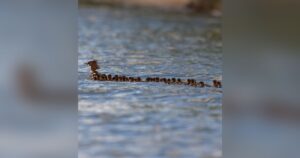Amazing, Cute Video Shows This Duck Supermom Leading 76 Ducklings

76 ducklings, one mother bird. Experts agree: That is one duckload of beaks to feed.
Do not let your eyes fool you. This incredibly charming photo is not the result of any Photoshop tricks or bird play. Brent Cizek, a nature photographer, captured this image in Lake Bemidji in northeastern Minnesota in late June. When he noticed the amazing procession—a single mother duck being followed by what appeared to be a small army of ducklings—he was swimming around in a small plastic boat.
Cizek estimated there were at least 50 ducklings in the image above when he was at home. But on other trips to the lake, he counted up to 76 baby quackers paddling with their mother.
In an apparent reference to the mother duck’s species, Cizek referred to her on Twitter as Mama Merganser. (Mama and her offspring are all Mergus mergansers, often known as common mergansers.) However, the puzzle of how one duck came to take care of almost 80 ducklings persisted.
While it’s not unusual to see 20 or 30 ducklings following a single mother, Kenn Kaufman, field editor for Audubon magazine, told Audobon.org that a group of 50 or more is quite amazing. There are likely a number of other avian peculiarities at work here.
To begin with, it is quite unlikely that all those ducklings were hatched by Mama Merganser herself. According to ornithologist Richard Prum, that is not feasible. Only about a dozen eggs can typically be laid at once by female ducks, who can also incubate up to 20 eggs. (Try to picture one duck carrying 80 eggs, and you’ll understand why this could be challenging.)
A peculiarity of the quacking race is how a mother duck may end up incubating more eggs than she really laid. You see, Kaufman explained, female ducks have a peculiar propensity for laying some of their eggs in the nests of other mothers. It’s not entirely apparent why a mother duck would do this, but it’s likely a means of making sure that at least some of her eggs had an opportunity to hatch even in the unfortunate event that something were to happen to her or her nest.
To put it another way, it might be a strategy for “not putting all [her] eggs in one basket,” according to Kaufman.
Ducky day care
The 20 or so ducklings following Mama around Lake Bemidji may therefore be a combination of her own children and some unintentional egg adoption, but what about the other 56? According to David Rave, a local wildlife manager for the Minnesota Department of Natural Resources who supervises the Bemidji region, they may be participants in a type of duckling daycare system known as a crèche.
According to Rave, female birds in a crèche leave the care of their young to an older, wiser female who acts as a sort of great-grandmother. While the young children’s parents are away performing crucial adult bird tasks, such as molting their feathers, an older babysitter, who is typically skilled in parenting young, is willing to take a few hatchlings under her wing.
This method is utilized by a number of bird species, including common mergansers, according to Rave. According to Rave, “I’ve seen crèches [of] up to 35 and 50 frequently, but 70 — that would be a very big crèche.”
In conclusion, it’s still difficult to solve the riddle surrounding Mama Merganser’s enormous brood. But it would definitely be wise to wait and observe how well these 76 tiny munchkins develop before we start handing out any Duck Mother of the Year honors. Keep in mind that not all adult ducks have happy relationships.




